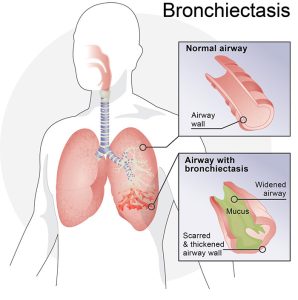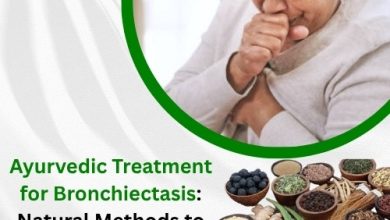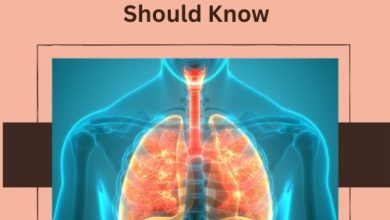Bronchiectasis Symptoms Explained Clearly: What to Watch For and Why It Matters

Introduction
Coughing every day, bringing up thick phlegm, and feeling tired all the time aren’t things to ignore—especially if they’ve been going on for weeks or months. These can be bronchiectasis symptoms, a sign your lungs need attention. Though the condition isn’t rare, many people don’t recognise its warning signs until it starts affecting their daily life. Understanding how this lung disease shows up in the body helps you take action sooner.
What Is Bronchiectasis?
Bronchiectasis causes damage to the airways (bronchi), leaving them widened and scarred. This makes it harder for the lungs to clear mucus properly, creating a build-up that can lead to infections and inflammation. Over time, the repeated cycle of infection and inflammation causes more damage, worsening symptoms.

Related Articles; What is Bronchiectasis, and How is It Treated?
It’s a long-term condition, but recognising symptoms early can improve quality of life and slow progression.
Early Symptoms of Bronchiectasis
Some of the first signs are subtle. You might mistake them for a lingering cold or a mild chest infection. But if they continue or keep coming back, they need attention. Here’s what to look out for:
1. Daily Cough with Mucus
One of the most common symptoms of bronchiectasis is a persistent cough that brings up sputum (phlegm). It often happens every day and may get worse in the morning. The mucus may be thick, sticky, and sometimes foul-smelling.
2. Recurring Chest Infections
People with bronchiectasis often get chest infections several times a year. These infections tend to last longer than usual and may need antibiotics. If you’ve been treated for bronchitis or pneumonia more than once in recent months, your doctor may want to investigate further.
3. Breathlessness
Breathlessness can happen even during light activity like walking or climbing stairs. This occurs because damaged airways can’t clear mucus properly, reducing airflow and making breathing harder.
Long-Term and Chronic Bronchiectasis Symptoms
When left untreated, symptoms become more noticeable and can impact your ability to carry out everyday tasks.
4. Fatigue and Low Energy
Chronic inflammation in the lungs forces your body to work harder just to breathe. This leaves you feeling drained, even after resting. Fatigue from chronic bronchiectasis symptoms can affect your work, relationships, and general wellbeing.
5. Wheezing and Chest Tightness
Some people develop wheezing, a high-pitched sound while breathing out. You might also feel pressure or tightness in your chest. These signs are similar to asthma but don’t always respond to asthma inhalers, especially if bronchiectasis is the root cause.
Related Articles; What is the Best Diet for Bronchiectasis?
6. Clubbing of the Fingers
Clubbing means the fingertips become rounder or more bulbous, often with the nails curving over them. While not everyone experiences this, it’s linked with long-term lung problems and may suggest a more advanced stage of the condition.
Infections and Sputum Changes
As bronchiectasis progresses, mucus becomes thicker and harder to clear. It may also change colour, turning yellow, green, or even streaked with blood. These changes often signal a flare-up or infection.
Warning Signs of Flare-Ups
- Increased coughing or mucus production
- Fever or chills
- Worsening breathlessness
- Chest pain when breathing deeply
If any of these appear suddenly or become more severe, seek medical help quickly.
What Are the Symptoms of Bronchiectasis in Children?
Children with bronchiectasis may have many of the same signs as adults, but they’re sometimes misdiagnosed with asthma or allergies. A chronic wet cough, poor growth, and frequent respiratory infections are important signs to watch for. If you suspect this in a child, a referral to a respiratory specialist can help confirm the cause.
Why Bronchiectasis Symptoms Are Often Misunderstood
The overlap with other lung conditions—like asthma, COPD, or chronic bronchitis—can make diagnosis difficult. You might have been treated for recurring chest infections for years without being offered further tests. That’s why it’s crucial to ask your GP directly, especially if your cough has lasted more than eight weeks or you’ve noticed changes in your sputum.
Related Articles; Best and Worst Foods for Bronchiectasis: Eat Smart to Breathe Easier
How Doctors Confirm Bronchiectasis
If a doctor suspects bronchiectasis, they usually refer you for a CT scan of the chest. This gives a clear image of the airways and can confirm widening or scarring. Other tests might include:
- Sputum cultures to check for bacteria
- Blood tests for signs of inflammation
- Lung function tests to assess breathing ability
Once diagnosed, treatment focuses on managing symptoms and preventing flare-ups.

Managing Bronchiectasis Symptoms at Home
While treatment plans vary by individual, some everyday habits can make a difference.
Daily Chest Physiotherapy
Using a technique called airway clearance helps remove mucus from the lungs. This can involve:
- Postural drainage (lying in different positions to help mucus move)
- Breathing exercises
- Devices like oscillating positive expiratory pressure (OPEP) tools
Staying Active
Gentle exercise improves lung function and helps clear mucus more effectively. Walking, swimming, and yoga are all helpful if done regularly.
Hydration
Drinking plenty of water thins mucus, making it easier to cough up. Try to aim for at least 6–8 glasses per day unless advised otherwise by your doctor.
Related Articles; Natural Treatments for Bronchiectasis That Can Support Your Breathing and Wellbeing
When to Seek Help for Bronchiectasis Symptoms
Some signs should never be ignored. Call your doctor if you notice:
- Coughing up blood
- Sudden weight loss
- High fever that lasts more than 48 hours
- Breathlessness that worsens quickly
Prompt Herbal Treatment for Bronchiectasis reduces the risk of permanent lung damage.
Lifestyle Tips to Reduce Symptom Flare-Ups
Managing symptoms bronchiectasis effectively means reducing the risk of infections and inflammation. Here are a few daily practices that help:
- Get vaccinated: Keep up to date with flu and pneumonia jabs.
- Avoid smoke and pollutants: Even passive smoke can worsen symptoms.
- Maintain oral hygiene: Gum infections can spread bacteria to the lungs.
- Use a humidifier: This keeps airways moist and may reduce coughing.
Emotional and Mental Impact
Living with daily symptoms can affect your mood. People often report feeling frustrated, isolated, or anxious—especially if coughing in public makes them feel self-conscious.
Support groups, counselling, and open conversations with loved ones all help manage the mental side of long-term lung conditions.
Summary: Take Symptoms Seriously, Act Early
Spotting bronchiectasis symptoms early gives you the best chance of keeping your lungs healthier for longer. Don’t assume a persistent cough is harmless or wait until breathlessness interferes with your day. If you’ve been wondering what is bronchiectasis symptoms, the answer lies in recognising patterns—cough, mucus, breathlessness—and acting on them.




